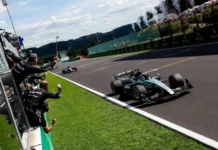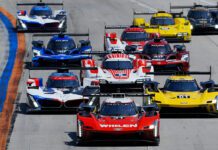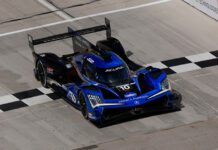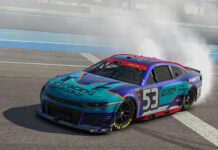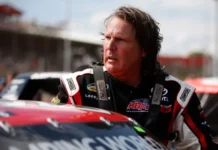The head of Chevrolet’s NASCAR program said a damaged prop shaft caused the mechanical failure for Tyler Reddick while leading Sunday in the Clash at the Coliseum.
The No. 8 Chevrolet was leading under caution during Lap 53 on the temporary 0.25-mile oval when Reddick suddenly slowed with what the Richard Childress Racing driver initially thought was a broken transaxle.
“He was getting ready to restart, trying to get heat in the tires and dropped the clutch a little too much, too abruptly,” Dr. Eric Warren, director of NASCAR Programs for General Motors, told NBC Sports in an interview Monday at the NASCAR Hall of Fame (where Jesse Iwuji‘s new No. 34 Chevrolet in the Xfinity Series was unveiled). “So it was damage with the prop shaft. It was not the transaxle. The drive shaft basically now is called the prop shaft with the way the transaxle works.
“I think (the Coliseum) track being really small, it’s a cause of a little concern at Martinsville just because that much gear and that violent of a restart probably would be something to think about. At the time, we hadn’t really seen that issue in the past, so we need to get into it a little bit. The cars had a lot more driveoff. I think a lot of drivers were surprised at how well they were able to drive off. There’s some technical work to see on was that (failure) unique to something we haven’t seen before? Was it a specific part failure? A new type of part? I’m sure we’ll dig into that in detail and have good answers.”
Sunday marked the debut of the Next Gen car, which is a revolutionary new concept in which Cup Series teams essentially are assembling spec-type cars with chassis, parts and pieces that are built by vendors. For the first 70-plus year of its existence, NASCAR allowed teams autonomy in building their cars from the ground up.
With the new degree of standardization in critical parts from single-source suppliers, there will be as much scrutiny of quality control as ever as a once-isolated problem easily could become widespread.
Warren said NASCAR increasingly is getting more input from teams now building their fleets for the 2022 season after an anxious offseason.
“NASCAR has been great, honestly, and it’s been a mountainous challenge,” Warren said. “They get a lot of input. They’ve responded as well as they can. With the supply chain issues, it’s been really hard. I think every team would wish they had more cars and parts, but the silver lining to the way the car is designed and intended was to have less cars. So now they’re going to be forced to deal with that and just like things breaking in testing, you don’t want to do it, but you learn things.
“The first part of the (Cup season) schedule, you see a little of everything. After you get through Phoenix, then probably Martinsville, you’ve hit most types of tracks and put the car through its paces. The durability of the car is much greater in general than the previous generation, so it’s just ironing out all the new parts with new vendors and making sure if there are some tweaks to the designs, it needs to happen.”
During the same caution period Sunday, Chase Briscoe had a drivetrain problem that “looked very similar” to Reddick’s, Warren said. “I don’t know if it was a similar issue, so we’ll have to digest as we go.”
Denny Hamlin also had a power steering belt apparently come loose, which Warren said wasn’t necessarily uncommon on the Gen 6.
“It sounded like something threw a belt,” he said. “That could have been the pump locked up. It’s hard to say yet if that was a steering rack issue. We’ve seen a lot of work and a lot of things over testing. Denny said the belt came off first, so that could be unrelated.”
With teams facing limited inventories of cars and parts heading into the Daytona 500, there was concern about an exhibition race on a short track producing wrecks that could exhaust their limited supplies. But Warren said even the most heavily damaged cars of Aric Almirola and Justin Haley should have a quick turnaround in getting repaired as soon as Monday.
“I think everyone was really worried about damaging cars with there not being that many of them, and looking at the damage of every car there, they’re probably already fixed,” Warren said. “The beauty of this car is how fast it can be repaired. I’m certain that any of those crashes I’ve seen, if there was a practice today, they’d be running. There was nothing significant. Even look at the crashes in testing. Austin Dillon’s crash in Charlotte, it was a really heavy crash, and they were back at the track the next day. The crashes from yesterday were pretty small.”

Many drivers also were encouraged that despite much beating and banging over the course of 150 laps, there seemed hardly any of the cut tires that often resulted from bent sheet metal after contact with the Gen 6.
Warren was “surprised” how well the Clash came off after being uncertain about the event despite GM engineers being able to predict precise lap times from Reddick’s work in the GM driving simulator.
“A quarter-mile is a really tight track, so with the brand new asphalt, we really went in not knowing if the track would be suitable for the cars,” he said. “Them being able to drive on the apron and everything was super exciting. The track held up great. The cars overall held up great considering the first race. Then the environment around it.”
Because the Cup schedule has no other quarter-mile tracks or similar weekend racing formats of heat and qualifying races, Warren said there was limited knowledge that can be gleaned from the L.A. event. But he was encouraged by the management of engine temperatures with less cooling options.
“This car has been tested more than any car, any new generation car, whether the COT or previous ones,” Warren said. “I’m confident in the car. There are going to be issues. I think the rest of the tracks, we’re going to see some durability things we haven’t seen. There have been a lot of miles put on the car definitely with all the testing NASCAR has done. But I think it’ll be different when we see it in real competition.”







